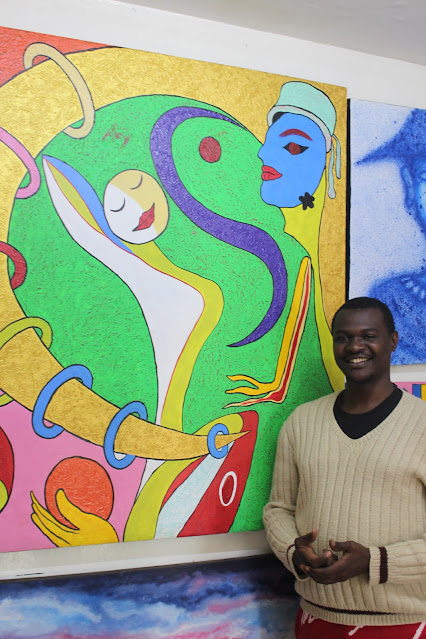Tucked away deep inside Nairobi’s so-called ‘biggest slum in Africa’, Kibera, one may have the good fortune to find the Uweza Gallery.
Before you can get there, though, you need to pass through two sets of guarded gates. Only then will you meet Frank Okoth and Wesley Osoro, two of the young artists and part-time art teachers who exhibit their paintings at Uweza and have been doing so for several years.
Yes, years. Uweza Gallery is not new. It was launched in 2012 by an American lady called Jen Sapitro who first established the Uweza Foundation in 2011, says Mr Okoth. Ms. Sapitro apparently had a large vision. She didn’t just set up an art project, which is what the gallery is part of. She also started boys and girls’ football (aka soccer) teams, and something called a ‘Bright Future for Young Mothers’ project. And she also set up an administrative structure wherein she is CEO and has a secretary and treasurer, although she doesn’t stay in Kenya and only comes here intermittently.
As I frankly
had never heard of Uweza Gallery before a friend recommend we go see it. He had
seen it advertised in some Ex-pat magazine, so I was curious. When we finally
reached the Gallery, we had to get through yet another metal gate, only to find
we were entering a house made over into a gallery, rather like the first house
that the Brush tu Artists Collective rented in Buru Buru Phase 1. The difference
is that Uweza’s hse is quite a bit smaller than Brush tu, and its front yard
has been transformed into an open-air artists’ studio.
At Uweza, there were two rooms downstairs where artworks filled every inch of wall space, including four panels erected as a tall rectangle in the centre of the room for exhibiting more artworks stacked practically one on top of the other.
The second room was just the same, and so was the upstairs. Making the most economical use of the limited space that they had, it was Frank Okoth who was on duty that day to answer our questions and show us around the Gallery.
“Ours is the largest art gallery in all of Kibera,” Osoro tells BDLife proudly. We noted we only knew of one other gallery in Kibera, Maasai Mbili. But Osoro wouldn’t retract his comment. “They are not as active as they used to be,” he says, possibly not knowing that Maasai Mbili artists are often invited out of the country to exhibit for extended periods of time.
For instance, Osoro was still in primary school when the Gallery got off the ground. He started taking those Saturday classes where Ms. Sapitro had provided the initial funds enabling the Saturday students to work with free art materials. These included canvas, acrylic paints, oil pastels, and brushes.
The Foundation’s business model works so that when an artwork is sold, the artist gets 60 percent of the sale, and the gallery get 40 percent. “That 40 percent goes towards paying the rent and covering the cost of art materials,” says Frank who adds the gallery is virtually self-sustaining. It also helps that the cost of the artworks is relatively inexpensive as compared to other upmarket galleries that feature widely known professional artists.







No comments:
Post a Comment